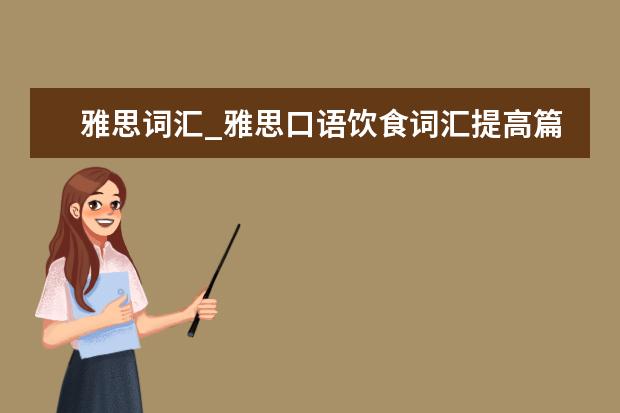雅思考试主要是通过对考生听、说、读、写四个方面英语能力的考核,综合测评考生的英语沟通运用能力,实现“沟通为本”的考试理念。对于雅思考生来说,也有很多考试难点和政策盲区需要帮助解答。今天雅思无忧网小编准备了雅思词汇_雅思口语饮食词汇提高篇:传统美食菜系 (Traditional Cate Cuisine),希望通过文章来解决雅思考生这方面的疑难问题,敬请关注。

近两年,因疫情关系,雅思考试出现了些不确定的因素,但是雅思考试的难度是不变的,希望同学们保持平常心,正常学习。以下是小编整理的雅思词汇_雅思口语饮食词汇提高篇:传统美食菜系 (Traditional Cate Cuisine)的内容,希望对你有所帮助!
总论
中国药膳不是食物与中药的简单相加,而是在中医辩证配膳理论指导下,由药物、食物和调料三者精制而成的一种既有药物功效,又有食品美味,用以防病治病、强身益寿的特殊食品。
源流
中国药膳原远流长。古代关于“神农尝百草”的传说,反映了早在远古时代中华民族就在开始探索食物和药物的功用,故有“医食同源”之说。公元前一千多年的周朝,宫廷医生
分为四科,其中的“食医”,即通过调配膳食为帝王的养生、保健服务。约成书于战国时期的中医经典著作《黄帝内经》,载药膳方数则。约成书于秦汉时期、我国现存最早的药学专著《神农本草经》,记载了许多既是药物又是食物的品种,如大枣、芝麻、山药、葡萄、核桃、百合、生姜、薏以仁等。东汉医圣张仲景在《伤寒杂病论》中,亦载有一些药膳名方,如当归生姜羊肉汤、百合鸡子黄汤、猪肤汤等,至今仍有实用价值。唐代名医孙思邈的《备急千金要方》和《千金翼方》专列有“食治”、“养老食疗”等门,药膳方药十分丰富。据史书记载,至隋唐时期,我国已有食疗专著约六十余种,惜多散佚。唐代孟诜所著《食疗本草》是我国现存最早的食疗专著,对后世影响较大。
至宋代,王怀隐等编辑的《太平圣惠方》论述了许多疾病的药膳疗法;陈直的《养老寿亲书》是我国现存的早期老年医学专著,在其所载的方剂中,药膳方约占70%。该书强调:“凡老人之患,宜先以食治,食治未愈,然后命药。”元代御医忽思慧所著的药膳专书《饮膳正要》,药膳方和食疗药十分丰富,并有任娠食忌、乳母食忌、饮酒避忌等内容。至明代,李时珍在《本草纲目》中收载了许多药膳方,仅药粥、药酒就各有数十则;明代高濂的养生学专著《遵生八笺》,也载有不少养生保健药膳。清代的药膳专著各有特色,如王士雄的《随息居饮食谱》介绍了药用食物七门三百余种,章穆的《调疾饮食辩》所涉及的药用食物更多,袁枚的《随园食单》介绍了多种药膳的烹调原理和方法,曹庭栋的《老老恒言》(又名《养生随笔》)中则列出老年保健药粥百种。
药膳的品种在传统工艺的基础上正在不为增加,如药膳罐头、药膳糖果等。结合现代科研成果制成的具有治疗作用的食品、饮料,品种繁多,各具特色。既有适合糖尿病、肥胖者和心血管疾病患者服食的药膳食品,也有适合运动员、演员和矿工等服食的保健饮料,还有促进儿童健康发育或用于老人延年益寿的保健食品或药膳。
中国药膳开始走向世界,不少药膳罐头和中药保健饮料、药酒等已销往国际市场。有的国家已经开设药膳餐厅。国际上一些学术界和工商界人士十分关注中国药膳这一特殊食品,希望能开展这方面的学术交流与技术合作。中国药膳将为世界人民的健康做出贡献。
特点
中国药膳具有以下特点:
1.注重整体,辩证施食
所谓“注重整体”、“辩证施食”,即在运用药膳时,首先要全面分析患者的体质、健康状况、患病性质、季节时令、地理环境等多方面情况,判断其基本证型;然后再确定相应的食疗原则,给予适当的药膳治疗。如慢性胃炎患者,若证属胃寒者,宜服良附粥;证属胃阴虚者,则服玉石梅楂饮等。
2.防治兼宜,效果显著
药膳既可治病,又可强身防病,这是有别于药物治疗的特点之一。药膳尽这多是平和之品,但其防冶疾病和健身养生的效果却是比较显著的。如山东中医学院根据古代食疗和清宫保健经验研制而成的“八珍食品”,含有山药、莲子、山楂等8种食用中药,幼儿食用30天后食欲增加者占97%,生长发育也有改善;再如,莱阳梨香菇补精,是由莱阳梨汁和香菇、银耳提取物制成,中老年慢性闩病患者服后不仅能显著改善各种症状,而且可使高脂血症者血脂下降,并可使免疫功能得到改善。
3.良药可口,服食方便
由于中药汤剂多有苦味,故民间有“良药苦口”之说。有些人,特别是儿童多畏其苦而拒绝服药。而药膳使用的多为药、食两用之品,且有食品的色、香、味等特性;即使加入了部分药材,由于注意了药物性味的选择,并通过与食物的调配及精细的烹调,仍可制成美味可口的药膳,故谓“良药可口,服食方便”。
general introduction
chinese medicated diet is not a simple combination of food and chinese drugs, but a special highly finished diet made from chinese drugs, food and condiments under the theoretical guidance of diet preparation based on differentiation of symptoms and signs of traditional chinese medicine
(tcm).
it has not only the efficiency of medicine but also the delicacy of food, and can be used to prevent and cure diseases, build up one's health and prolong one's life.
origin and development
chinese medicated diet has a long history. the ancient legend "shennong tastes a hundred grasses "shows that early in remote antiquity the chinese nation began to explore the function of food and medicaments, hence the saying "traditional chinese medicine and diet both originate from the practice and experience in daily life."
in the zhou dynasty, one thousand or more years b. c. , royal doctors were divided into four kinds. one of them was dietetic doctors who were in charge of the emperor's health care and health preservation, preparing diets for him.
in the yellow emperor's internal classic, a medical classic in tcm which appeared approximately in the warring states period, several medicated diet prescriptions were recorded. in shennong's herbal classic, which was published approximately in about the qin and han periods and is the extant earliest monograph on materia medica, many sorts of medicaments which are both drugs and food were recorded, such as chinese-date (fructus ziziphi jujubae),sesame seed (semen sesami), chinese yam (rhizoma dioscoreae), grape (vitis), walnut kernel (semen fuglandis), lily bulb (bulbus lilii) , fresh ginger (rhizoma zingiberis recens), job's-tears seed (semen coicis), etc. in the book treatise on febrile and miscellaneous diseases written by zhang zhongjing, a noted medical man, in the east han dynasty, some noted medicated diet recipes were recorded, such as soup of chinese angelica root, fresh ginger and mutton (danggui shengjiang yangrou tang ), decoction of pig-skin(zhufu tang), etc., all of which now still have important values. sun simiao, a well-known doctor in the tang dynasty, listed and discussed such questions as dietetic treatment, dietetic treatment for senile health care and health preservation, etc. in his books prescriptions worth a thousand gold for emergencies and a supplement to essential prescriptions worth a thousand gold for emergencies. these two books were substantial in medicated diet prescriptions.
according to history books, up to the period of the sui and tang dynasties about more than sixty kinds of books on dietetic treatment had been published. but unfortunately most of them are lost. the book dietotherapy of materia medica by meng xian in the tang dynasty has a great influence on later generations. it is the extant and earliest monograph on dietetic treatment.
in the song dynasty, wang huaiyin and some others wrote peaceful holy benevolent prescriptions, in which they discussed medicated diet treatment for many diseases. a book on how to help the old to preserve health and your kith and kin to prolong their lives by chen zhi is an extant early monograph on gerontology in china. of all the prescriptions recorded in it, 70% are about medicated diet. it is emphasized in this book that "dietetic therapy should go first for any senile diseases, and then followed by medicine if they are not cured. " in the book principles of correct diet, a monograph on medicated diet, by hu sihui, a royal doctor in the yuan dynasty, oceans of medicated diet prescriptions and dietetic drugs were recorded; in addition, some questions, such as diet contraindication in pregnancy, diet contraindication for wet nurse, contraindication for drinking, etc. were also discussed in this book. in the ming dynasty, li shizhen collected and recorded in his compendium of materia medica many medicated diet prescriptions, dozens of which were about medicated gruel alone, and another dozens of which touched on nothing other than medicated wine. ineight essays on life preservation, a monograph on health preserving in the ming dynasty, many medicated diets on health preserving and health care were recorded too. monographs on medicated diet treatment in the qing dynasty varied in characteristics: in recipe of suixiju by wang shixiong, over 300 species belonging to 7 phyla of medicated food and drink were introduced; in *ysis of food and drink for treatment of diseases by zhang mu, more medicated foods were touched upon; in cookbook of suiyuan cooking principles and methods were dealt with; while in common saying for senile health preservation, also known as jottings on health preservation, by cao tingdong, about 100 medicated gruel prescriptions for gerocomy were listed.
medicated diet has been developing greatly in assortment on the basis of traditional process, for example, medicated can, medicated sweets and so on. salutary food and drinks produced on the basis of achievements in scientific research and having the effect of curing diseases have a variety of sorts and vary in characteristics. there is medicated food suitable for patients suffering from diabetes, obesity and angiocardiopathy; there are health-care food and drinks suitable for athletes, actors, actresses and miners; there are also health- care food or medicated diets suitable for the promotion of children's health and growth, or for prolonging life of the aged.
chinese medicated diet has begun to go abroad. medicated cans, health-care drinks and medicated wine made from traditional chinese medicine have been sold at the international market. medicated diet dining- halls have been set up in some countries. personnel of academic, industrial and commercial circles abroad have paid close attention to chinese medited diet-a special food, hoping to develop academic exchanges and technical and economic cooperation in this respect. chinese medicated diet will make contributions to the health of the people all over the world.
characteristics
the characteristics of chinese medicated diet are as follows:
1. laying stress on the whole and selecting medicated diet on the basis of differential diagnosis
by " laying stress on the whole and selecting medicated diet on the basis of differential diagnosis ", we mean that when prescribing medicated diet, we should first make an overall *ysis of the patient's physical and health condition, the nature of his illness, the season he got ill in and the geographical condition, etc, to form a judgment on the type of syndrome; then decide on corresponding principles for dietetic therapy and select suitable medicated diet. take a patient with chronic gastritis, as an example. he should take galangal and cyperus gruel (liangfu zhou) if he suffers from chronic gastritis of stomach-cold type, but he can take drink of fragrant solomonseal rhizome, dendrobium, black plam and hawthron fruit (yu shi mei zha yin) if he suffers from chronic gastritis due to deficiency of the stomach-yin.
2.suitable for both prevention and treatment, and outstanding in effect
medicated diet can be used either to treat diseases or for healthy people to build up their health and prevent diseases. this is one of the characteristics in which medicated diet is different from treatment by medicine. although medicated diet is something mild, it has a notable effect on the prevention and cure of diseases, health building -up and health preserving. here are some of the achievements in scientific research of shandong traditional chinese medicine college:
eight-ingredient food:it is prepared according to the experience in ancient dietetic treatment and health care of imperial court in the qing dynasty from eight dietetic chinese drugs including chinese yam (rhizoma dioscoreae), lotus seed (semen nelumbinis), hawthorn fruit (fructus crataegi). 997% of the children who took it for 30 days have whetted their appetite, and their growth has been improved too.
nourishing extract of laiyang pear and mushroom: it is made from the juice of laiyang pear (malum piri) and extract of mushrooms ( lentinus edodes) and tremella (tremella). if the middle-aged and senile patients suffering from chronic diseases take it, not only can the symptoms of their illness be alleviated, but their blood-fat can be brought down too when they are suffering from hyperlipemia, and their immunologic function can be improved.
3. good in taste and convenient for taking
there goes the saying "good medicine tastes bitter" among the people, because most of the decoctions of chinese drugs are bitter. some people , especially children, take an aversion to the bitterness of chinese drugs and refuse to take them. most of the drugs used in medicated diet are both edible and medicinal, and retain the properties of food: colour, sweet-*elling, flavor, and so on. even if part of them are chinese herbs, their nature and flavor are taken into consideration so that they are made into tasty medicated diet by mixing them with food and by careful cooking.
以上就是雅思无忧网为您准备的访问雅思无忧网(https://www.yasi.cn/),了解更多雅思考试新消息,新动态。
雅思培训
免责声明:文章内容来自网络,如有侵权请及时联系删除。


 雅思口语话题:Are there any traditional dances?
雅思口语话题:Are there any traditional dances?
 雅思口语part2话题练习:A traditional(happy) event
雅思口语part2话题练习:A traditional(happy) event
 雅思口语话题解析:a traditional Chinese festival
雅思口语话题解析:a traditional Chinese festival
 雅思口语part2话题练习:Traditional Event
雅思口语part2话题练习:Traditional Event
 雅思口语话题卡练习:Traditional Event
雅思口语话题卡练习:Traditional Event
 雅思口语素材积累:A traditional festival
雅思口语素材积累:A traditional festival
 雅思口语范文:A traditional festival
雅思口语范文:A traditional festival
 雅思口语九级分析真题 雅思口语。What the traditional festival is? - 百...
雅思口语九级分析真题 雅思口语。What the traditional festival is? - 百...
 雅思口语思路分析之A traditional festival
雅思口语思路分析之A traditional festival
 雅思口语话题思路分析之A Traditional Event
雅思口语话题思路分析之A Traditional Event